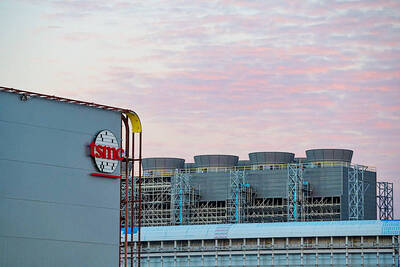Taiwan’s export-oriented economy is expected to grow by less than 3 percent this year, as heavier-than-expected “reciprocal” US tariffs of 32 percent are to deal a blow to the nation’s manufacturing sector and exports, analysts and economists said.
Taiwan’s first-order impact could be significant, as its reciprocal tariff rate is unexpectedly high at 32 percent, DBS Group Holdings Ltd economist Ma Tieying (馬鐵英) said in a report yesterday.
That is above the Asian average of 28 percent and the overall average of 29 percent across the 60 affected nations, Ma said.

Photo: CNA
The second-order impact further exacerbates Taiwan’s vulnerability, she added.
“We foresee significant downside risks to our GDP growth forecasts for 2025 and 2026, currently projected at 3 percent and 2.4 percent, with particular concern from the 2026 outlook,” Ma said in the report. “Taiwan’s vulnerability stems from its high exposures to the US export market.”
Taiwan’s exports to the US last year accounted for 23 percent of total exports and 14 percent of nominal GDP, making the nation the second-most vulnerable economy in Asia to the first-order impact of reciprocal tariffs, just behind Vietnam, the report said.
As Taiwan’s GDP is highly dependent on exports for growth, the second-order impacts on Taiwan could also be significant, as the US and global economy are at risk of recession, with shrinking trade volumes in major economies such as the US, China, Japan and Europe.
Exports accounted for 63 percent of Taiwan’s nominal GDP last year, the fifth-highest level in Asia.
“This high dependence on exports makes Taiwan particularly vulnerable to a global economic downturn,” Ma said.
By segment, the electronics, plastics and textile sectors would be affected the most by the tariffs, as semiconductor, steel and pharmaceuticals imports to the US are tentatively spared from the duty, Yuanta Securities Investment Consulting Co (元大投顧) said in a report on Thursday.
“If all the tariffs take effect as scheduled, Taiwan’s economic growth this year will be less than 3 percent,” the investment consultancy said.
The estimate includes indirect impact from the decline in global trade and the economy.
Yuanta expects US tariffs to reduce GDP growth by 0.8 percentage points directly and 0.24 percentage points indirectly from its original forecast.
Taiwan’s GDP could grow just 2 percent on an annual basis this year, as the US tariffs would weaken exports, Cathay Securities Corp (國泰證券) said in a separate report on Thursday.
That would be significantly lower than the 3.14 percent growth forecast by the Directorate-General of Budget, Accounting and Statistics in February.

Shiina Ito has had fewer Chinese customers at her Tokyo jewelry shop since Beijing issued a travel warning in the wake of a diplomatic spat, but she said she was not concerned. A souring of Tokyo-Beijing relations this month, following remarks by Japanese Prime Minister Sanae Takaichi about Taiwan, has fueled concerns about the impact on the ritzy boutiques, noodle joints and hotels where holidaymakers spend their cash. However, businesses in Tokyo largely shrugged off any anxiety. “Since there are fewer Chinese customers, it’s become a bit easier for Japanese shoppers to visit, so our sales haven’t really dropped,” Ito

The number of Taiwanese working in the US rose to a record high of 137,000 last year, driven largely by Taiwan Semiconductor Manufacturing Co’s (TSMC, 台積電) rapid overseas expansion, according to government data released yesterday. A total of 666,000 Taiwanese nationals were employed abroad last year, an increase of 45,000 from 2023 and the highest level since the COVID-19 pandemic, data from the Directorate-General of Budget, Accounting and Statistics (DGBAS) showed. Overseas employment had steadily increased between 2009 and 2019, peaking at 739,000, before plunging to 319,000 in 2021 amid US-China trade tensions, global supply chain shifts, reshoring by Taiwanese companies and

Taiwan Semiconductor Manufacturing Co (TSMC) Chairman C.C. Wei (魏哲家) and the company’s former chairman, Mark Liu (劉德音), both received the Robert N. Noyce Award -- the semiconductor industry’s highest honor -- in San Jose, California, on Thursday (local time). Speaking at the award event, Liu, who retired last year, expressed gratitude to his wife, his dissertation advisor at the University of California, Berkeley, his supervisors at AT&T Bell Laboratories -- where he worked on optical fiber communication systems before joining TSMC, TSMC partners, and industry colleagues. Liu said that working alongside TSMC

TECHNOLOGY DAY: The Taiwanese firm is also setting up a joint venture with Alphabet Inc on robots and plans to establish a firm in Japan to produce Model A EVs Manufacturing giant Hon Hai Precision Industry Co (鴻海精密) yesterday announced a collaboration with ChatGPT developer OpenAI to build next-generation artificial intelligence (AI) infrastructure and strengthen its local supply chain in the US to accelerate the deployment of advanced AI systems. Building such an infrastructure in the US is crucial for strengthening local supply chains and supporting the US in maintaining its leading position in the AI domain, Hon Hai said in a statement. Through the collaboration, OpenAI would share its insights into emerging hardware needs in the AI industry with Hon Hai to support the company’s design and development work, as well